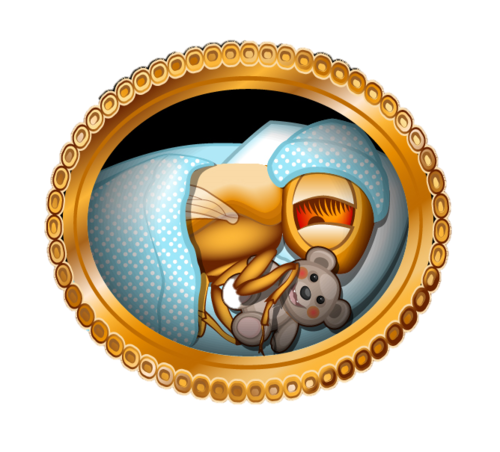Convergent deficits of memory consolidation in aged and sleep-deprived Drosophila
sleep
Image Credit: THE WHY FILES: THE SCIENCE BEHIND THE NEWS©2017 UNIVERSITY OF WISCONSIN BOARD OF REGENTS
https://whyfiles.org/2014/fruit-fly-study-finds-long-term-impact-of-sleep-deprivation/index.html 2018 May, 22
Sleep has been found to support memory consolidation in a spectrum of model organisms and the human being. With increasing organismal age, however, sleep fragments and memory consolidation attenuates. By which mechanisms and at what level the aging process intersects with memory consolidation and sleep remains largely unclear. In aging Drosophila
fruit flies, consolidation of classical conditioned olfactory memory becomes inefficient and the number of sleep episodes increases. We will use this model to investigate this intersection concentrating on a brain-wide metaplastic change of synapses (increase of presynaptic active zone sizes) we recently found in aged flies. When we mimicked this metaplasticity genetically (by elevating the gene dose of active zone scaffold proteins), memory consolidation decreased and the number of sleep episodes increased, similarly to aged flies. Here, we will reprogram presynaptic plasticity within relevant neuronal populations in order to learn about the synaptic and circuitry principles connecting aging, sleep and
memory consolidation. Thus, we will measure how behavioral responses, such as olfactory aversive learning and sleep, are affected by opto-physiological methods combined with genetic manipulation. In addition, dorsal paired medial neurons will be specifically analyzed, as they have been previously shown to promote olfactory memory consolidation, and their artificial stimulation influences sleep and can compensate for age-induced deficits of consolidation. We will also use spermidine feeding as a protective paradigm, found to alleviate age-induced effects on memory consolidation. This strategy should help us to further separate causal entities from epiphenomena at the intersection of age, memory consolidation and sleep. Sleep is universal across species and essential for qualitative life and health. Sleep in Drosophila and humans has marked similarities, making the fruit fly a powerful genetic model in which to study sleep syndromes. Several drugs and signaling pathways affect sleep in flies and mammals in a similar manner, including arousal-promoting dopaminergic signaling. Drosophila emerged as a sleep model almost two decades ago. Under laboratory conditions, fruit flies walk for a large portion of their waking time, and locomotor data collected from Trikinetics monitors originally designed for circadian rhythm behaviors, have been widely used for quantitative sleep analysis. In this field, an episode of immobility for 5minutes or longer without beam crossings was defined as sleep due to the increase of arousal threshold and modulations of synapses and circuitries. In this way, several large-scale screens were performed and more than 40 genes relevant for sleep were identified. Like humans, flies are more active by day and sleep mostly during the night. This pattern, however, deteriorates with age: duration of day sleep increases, and sleep bouts increase in number, sleep latency shortens while sleep bout length shortens, collectively referred to as sleep fragmentation).
Over the last years, Pavlovian olfactory learning has become a leading paradigm to mechanistically study memory processes at the circuit and the synapse level in the Drosophila model. The mushroom body (MB) is a key brain area for olfactory learning in this organism. Recently, comprehensive anatomical information and genetic tool sets were made available for the MB circuit. This greatly accelerated the physiological understanding of the learning process. One of the key findings was dopamine-induced long-term synaptic plasticity that can alter stimulus valence. Like mammals, the fruit fly Drosophila consolidates memories at the systems level. Critical memory information is transferred from short-term storage in neurons required for initial acquisition to anatomically and physiologically distinct long-term storage sites. While the anatomy involved in memory consolidation in mammals is highly complex and distributed, aspects of consolidation in the fly are simpler. Retrieval of punitive and rewarded odor memories depends on output from MB neurons. Moreover, the dorsal paired medial (DPM) neurons, a single pair of neurons innervating all of the MB axonal extensions (“lobes”), contribute to the consolidation of odor memories. DPM neurons, along with the α’/β’ subset of MB neurons, are required for early phases of this memory information transfer. In Drosophila, memory acquired after a single olfactory conditioning cycle (short-term memory) can be consolidated into intermediate- and long-lasting components. DPM neurons innervate the MBs, and DPM neuron output is required for the stability of punished odor memory. Intermediate term aversive olfactory memory can be further dissected into anesthesia-sensitive memory (ASM) and anesthesia-resistant memory (ARM) components, dependent on their sensitivity to amnestic cooling. This distinction is vitally important from a theoretical point of view because it delineates mechanisms for memory consolidation that are activity-dependent from processes that are either more structural or captured in biophysical changes. This topic lies at the heart of mechanistic understanding of memory consolidation as a whole and applies in all systems (e.g. mammalian cortex, etc.). Of particular importance to our group are aversive olfactory memories (in response to electric shocks) are subject to ageinduceddecline in Drosophila, as first shown by the Saitoe lab . Unlike ARM, which is stable with age, it is the ASM component whose consolidation is strongly impaired with aging. Here, decay of memory scores shows an onset at about 10 days ofage and plateaus at about 30 days of age. The ASM component needs DPM activity to form mid-term (3 hrs aftertraining) and long-term memory. The latter also is largely impaired by aging.

